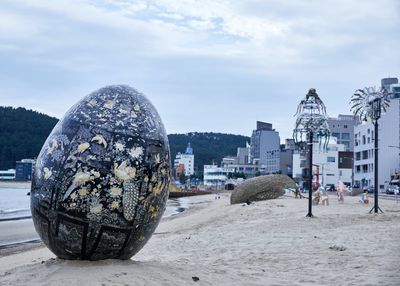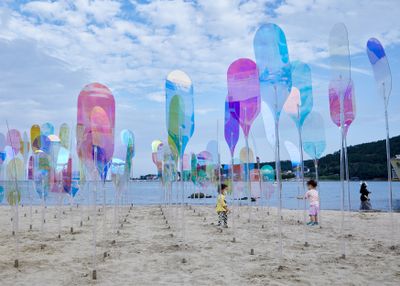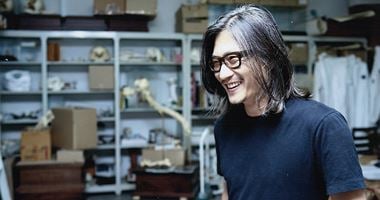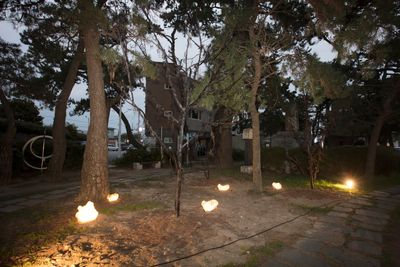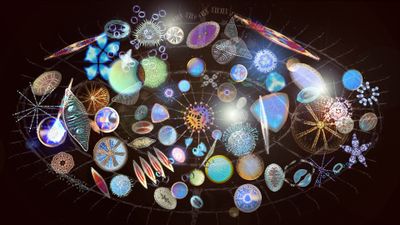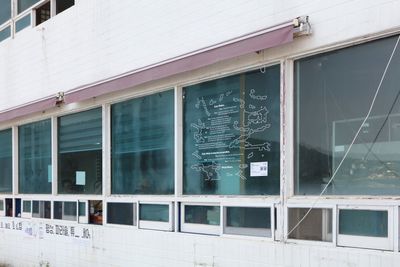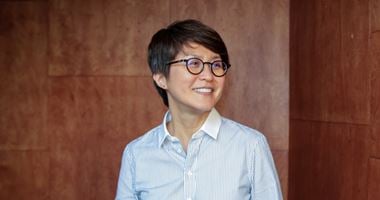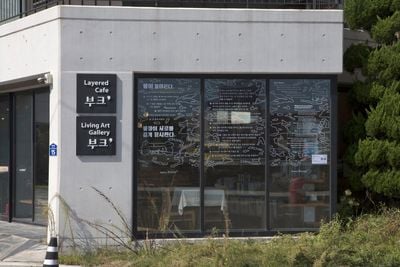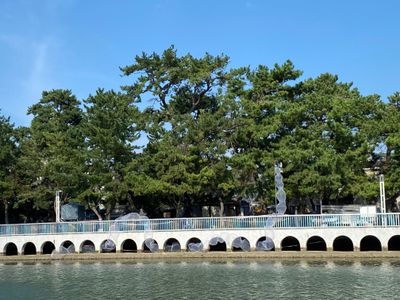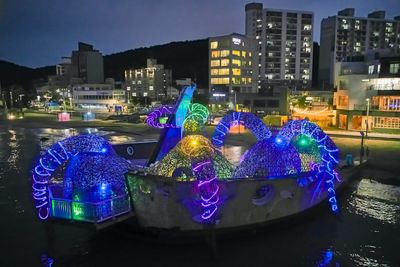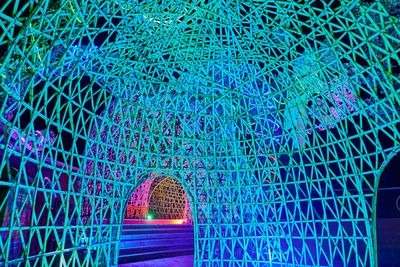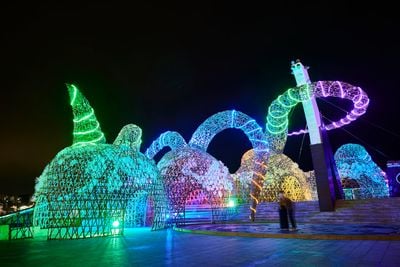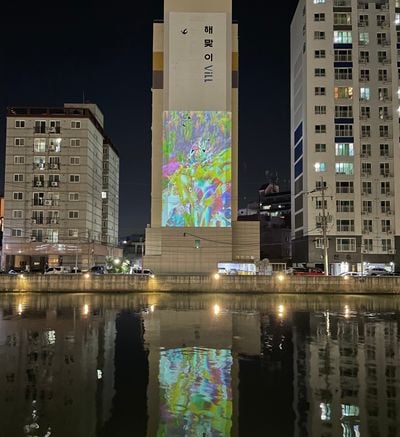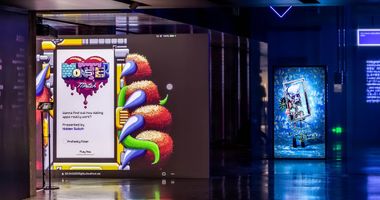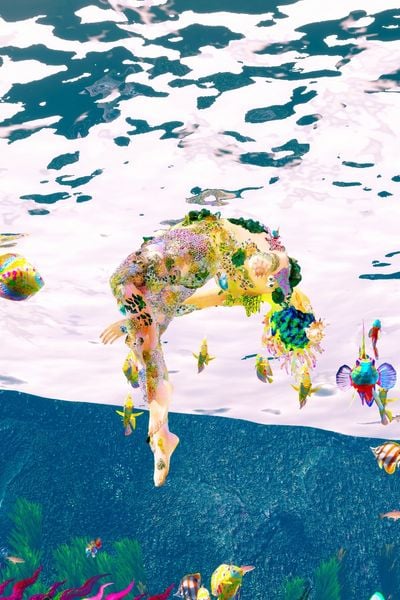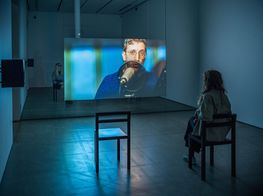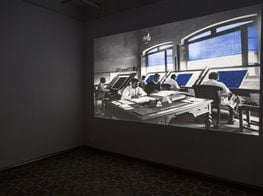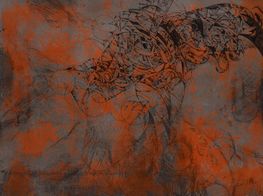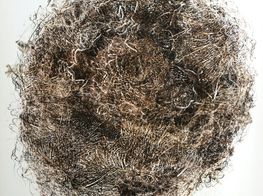Across a Seaside Village in Busan, Sea Art Festival Reimagines the Ocean
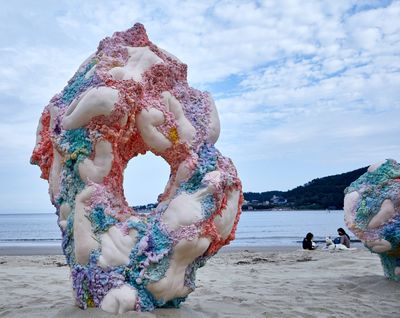
Ryu Yejun, Archipelago of Dream-Folds (2021). Exhibition view: Non-/Human Assemblages, Sea Art Festival 2021, Busan (16 October–14 November 2021). Courtesy © Busan Biennale Organizing Committee.
Taking place every odd-numbered year since 2011, Sea Art Festival, established by the Busan Biennale Organizing Committee in 1987, aims to reinterpret seaside sites in Busan, South Korea.
This year's edition, Non-/Human Assemblages (16 October–14 November 2021), conceives of the ocean as a swirl of human and non-human encounters, and marks a dynamic change for the event, with its first foreign and first female artistic director, Ritika Biswas, and a focus on the outskirts of Busan.
Compared to previous editions, with venues at touristic beaches like Songdo Beach and Dadaepo Beach, Sea Art Festival 2021 is spread across a small seaside village in Ilgwang Township, Gijang County, including the Ilgwang Beach on the East Sea, with 22 site-specific projects by 36 local and international artists, among them Lawrence Abu Hamdan, Raqs Media Collective, and OBBA (Sojung Lee and Sangjoon Kwak).
Inspired by the work of scholars Jasbir K. Puar and Astrida Neimanis, the festival reflects on the interrelations between time, space, and entities, with artworks functioning as portals into the ocean as a world unto its own.
Throughout, encounters between humans and non-humans unfold. Lee Jin Sun's site-specific installation The DNA Park (2021), located in Gangsongjeong Park, wraps strands of hair from local residents, which the artist collected at a local hair salon, around tree branches throughout the park.
To see human hair detached from the body and recombined with nature feels eerie, confronting, and stimulating. Families and the elderly around the park, whether having lunch or resting on benches, were heard constantly talking about these hybrid assemblages.
At night, LED lights embedded in the artificial stones transforms them into what looks like deep-sea ore glowing with fluorescent light.
Transforming itself from day to night, The DNA Park conceives a world drawn out from overlapping states, whether underwater or imaginative, locating living organisms beyond the dichotomies that separate human and nonhuman.
Rohini Devasher's illuminous single-channel video work, Glasshouse Deep (2021), projected onto the sand of Ilgwang Beach at night, creates another threshold into underwater realms by enhancing images of diatoms (oceanic microalgae), which can otherwise only be seen through microscopy.
The diatoms presented in Glasshouse Deep are based on specimens collected from the East Sea by the Korea Institute of Ocean Science and Technology in Busan. The projection starts with one entity, until a diverse collection of diatoms of various fluorescent colours gradually appear.
These creatures, mostly circular or oval with small tentacles, are constantly moving. Through this action, the sand around them takes on the quality of water.
Relations stretch from the festival's immediate context to the broader geopolitical world in Ru Kim's theatrical textual work Strategies of Dissolution (2021), a series of vinyl-lettered texts about the transcorporeality of water attached to windows of five central locations in this seaside village, such as cafes and restaurants.
In the texts, bodies of water talk about how they were tested at Gijang's desalination plant, once the largest in South Korea, and now a research centre after protests by Gijang residents who were concerned that the seawater could be contaminated by the nearby Kori Nuclear Power Plant.
Throughout the festival, dynamic encounters weave metaphorical bodies of water with the actual sea that laps its coastlines...
One conversation mentions 'K-water', the name for the Korea Water Resources Corporation since 2006. These K-waters introduce themselves with names such as 'Korea Water' and 'Kingdom of Water Service', which resonates with the manufactured mass production of K-pop.
'I [have] heard something about [the] expansion of K-water elsewhere,' says one water body, to which another replies: 'K-water? Makes me feel like a pop star.' Then, another water body raises a crucial question about what is sacrificed in extractive industrialisation: 'Do pop stars sacrifice their local population for broader appeal?'
In wondering why human bodies need so much energy production, this watery play implicates state and corporate bodies that drive the drama to which these K-water characters are witnesses. Namely, the city of Busan, Doosan Heavy Industries & Construction, and the Kori Nuclear Power Plant.
Ru Kim expands the conversation by imagining an encounter between Gijang's waters and those of the Mediterranean, where countless refugees have drowned due to the restrictive actions of border control agency Frontex and complicit European nations. In the text, waters comfort each other as they unwillingly become the stage for violence, before deciding to merge and take action.
As if poised to take off from the land's edge is Leeroy New's Anito (2021): a gigantic bamboo architectural installation that looks like a sea creature emerging from a boat-shaped structure at Ilgwang Beach, which was used for musical fountain shows before the pandemic.
Three domed forms and multiple tentacles appear to dance on the water, with small plastic bottles covering the construction's exterior like suckers forming a beautiful abstract pattern. Inside, a series of passages lead visitors to face the sea, with plastic bottles hung like chandeliers from the ceilings.
At night, this tremendous creature changes its appearance completely with colourful spotlights, its delicate bamboo tentacles morphing into something more like a theme park rollercoaster.
But while this showy multicoloured structure is visually impressive, it also intends to prompt visitors to consider the oceans as geopolitical space.
The suction of plastic bottles and the sea's perpetual waves alludes to colonial waste flowing into the waters of developing countries across the world, such as the Philippines, where colonisation historically consumed Filipino folk cultures and traditions. The installation's title, 'Anito' refers to nature spirits and deities from indigenous Filipino folk stories.
Another projection merging past and future is Anna Kim's single-channel video work, The Ocean Machine (2021), which offers a proposal of solidarity among humans, technology, and nature. Projected on the façade of an apartment building located across from Gangsongjeong Park, the animated film plays between 6 and 9pm each night, telling a story of an encounter between a dragon goddess and an ocean machine.
Kim is a senior researcher at the Korea Research Institute for Culture Technology. To create an ocean machine capable of solving the problem of microplastics in the ocean, she trained artificial intelligence with various texts about the shape and operation of the possible machine and used the results to digitally render its construction. The result looks like a pearl with a cape and vacuum motor.
In the digital projection, the façade of the building is turned into the dragon goddess's underwater domain, as she works with the ocean machine to remove all microplastics from the waters, restoring the ocean's coral reefs and reviving its blue dragon in the process.
Excerpts from The Ocean Machine are being screened at intervals on the recently constructed media wall at Busan Station, called the Busan Eurasia Platform—a gesture of accessibility that reflects how Sea Art Festival has swept through this seaside village and engaged with its community.
Throughout the festival, dynamic encounters weave metaphorical bodies of water with the actual sea that laps its coastlines, offering a more liquid worldview in which mutual codependence, beyond the binary of human and nonhuman, can be conceived. —[O]

